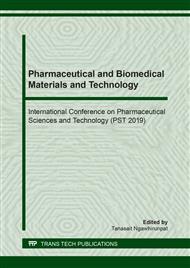p.45
p.51
p.57
p.63
p.73
p.79
p.85
p.92
p.98
Extraction Method of Protein and Insulin-Like Growth Factor-1 from Deer Antler Velvets for Skin Rejuvenation
Abstract:
Deer antler velvets (DAVs) contain many growth factors and protein. To extract growth factor from DAV, the suitable method and material properties have to investigate. The aim of this study was to improve the growth factor content in DAV extract for using as a skin rejuvenation compound. Different extraction methods (such as ethanol extract, probe sonication and precipitation method) and material preparations (such as fresh, dried by freeze drier and dried by hot air oven with and without gramma ray) were performed to evaluate the total protein and insulin-like growth factor-1 (IGF-1). The suitable condition was choose to determine the antioxidant activity and effect on the skin properties (such as in vitro skin permeation and in vivo human studies). For the results, fresh DAV extracted by probe sonication method provided the significantly highest total protein (586.31 + 48.17 mg/g) and IGF-1 (31.32 + 10.55 ng/g) contents. At the concentration of 2,000 μg/ml, this extract was completely dissolved in water and exhibited the antioxidant potential nearly 50% inhibition. For skin permeation at 24 h, the skin treated with DAV extract showed 3.83 + 2.04% of protein permeated through skin. The skin elasticity and hydration significantly increased after applying DAV extract for 28 days. In conclusion, the DAV extract by using fresh DAV and probe sonication method exhibited high IGF-1 and protein content as well as an antioxidant potential, leading to improve the skin properties. This extract might play an important role in the skin rejuvenation product.
Info:
Periodical:
Pages:
73-78
Citation:
Online since:
August 2019
Price:
Сopyright:
© 2019 Trans Tech Publications Ltd. All Rights Reserved
Share:
Citation:


